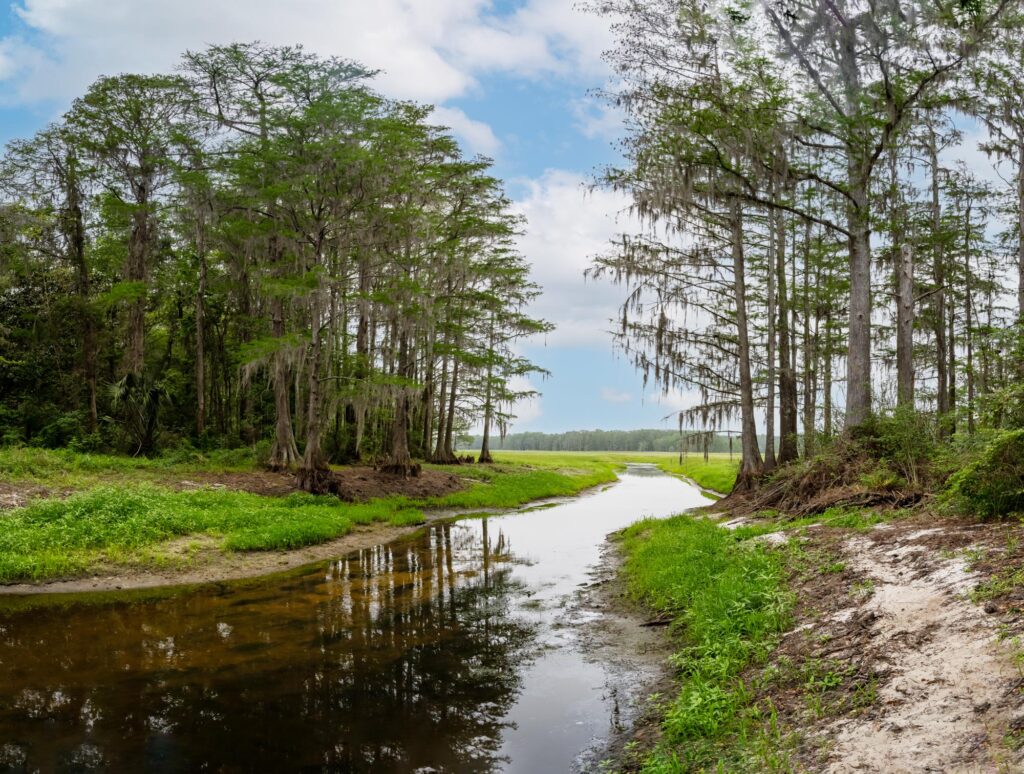
Lake Munson, a freshwater lake southwest of Tallahassee, has been a focal point of environmental concern for decades due to pollution and degraded water quality.
Despite recent restoration efforts, including a significant drawdown, the lake’s future remains uncertain. County officials and local experts agree that Lake Munson has improved but have different opinions on the outlook for its long-term health and the strategies needed to sustain it.
Anna Padilla, Leon County’s stormwater management coordinator, and Max Epstein, a researcher at Florida State University’s DeVoe L. Moore Center and Friends of Lake Munson, Inc. member, discussed these efforts and offered contrasting perspectives on the lake’s condition and path forward.
Pollution in Lake Munson has accumulated over many years, driven by wastewater discharges and runoff from urban development in the 1980s, before modern environmental regulations were in place. Padilla noted that extensive investments in upstream stormwater treatment systems, including stormwater ponds and significant restoration projects, have helped filter contaminants before they reach the lake. “We’re seeing better water quality than we’ve had in years,” Padilla said, underscoring recent improvements.
Epstein agrees that stormwater treatment has helped but cautions that Lake Munson remains vulnerable. “Munson is essentially the endpoint for all the runoff from about 30,000 acres, including much of urban Tallahassee,” Epstein said.
He noted that, although restoration efforts are underway, more attention needs to be directed toward removing legacy pollutants like heavy metals and phosphorus from the lakebed sediment to ensure long-term stability.
In November 2022, Leon County began a drawdown, a controlled draining of the lake to expose sediment at the lakebed to sunlight and air, which helps reduce nutrient release. The drawdown concluded in May 2023 and allowed for sediment compaction, a process beneficial to water quality.
“The drawdown was a way to give Lake Munson a fresh start,” Padilla explained. “By lowering the water level, we allowed the muck and sediment to consolidate, which helps create a healthier environment for fish and other wildlife.”
Epstein initially supported the drawdown as a step toward restoring the lake but expressed frustration with how the extended drawdown was handled. “While the drawdown compacted sediments, it also allowed dense vegetation to establish itself,” Epstein said.
According to Epstein, this overgrowth now makes much of the lake unnavigable and has complicated water quality management. He recommended that Leon County take more immediate action, such as using mechanical harvesters to remove vegetation and nutrients from the lake rather than relying solely on natural regrowth.
Lake Munson’s water quality has shown some improvement, and Padilla describes its current condition as stable, with a positive trajectory.
“Our goal is to create a resilient ecosystem that can sustain itself,” Padilla said, noting that monthly vegetation treatments are ongoing to promote native species’ growth and improve the ecosystem’s resilience. However, she emphasized that this is an “active management process,” requiring continuous monitoring and intervention to maintain water quality.
While hopeful for short-term improvements, Epstein is less optimistic about the lake’s long-term stability. He advocates for dredging as a solution to remove legacy nutrients from the sediment, something he says was part of a county plan that has yet to be fully implemented.
“The drawdown alone isn’t a permanent solution,” Epstein said, adding that without a comprehensive plan to address pollutants, any gains in water quality are likely to be temporary.
“We’ve seen this before — temporary improvements that fade as sediment nutrients reintroduce algae and other issues,” he said. However, Friends of Lake Munson believe it is critical of what they perceive as a lack of contingency planning. “There’s a lot of ‘wait-and-see,’ but we need a proactive plan if the water quality deteriorates again,” he said.
State officials claim Lake Munson is considered a class 3 recreational body of water, meaning people are supposed to be able to swim in or fish from the lake, but Epstein states that’s far from the case.
“Whenever I hear from the county that [the lake] is in the best shape ever… I invite them personally to take a dip and a swim in the lake and I have not gotten a single person to take me up on it,” Epstein remarks.
According to Epstein, Friends of Lake Munson has been pushing for more immediate action, including grant proposals for further research and dredging feasibility studies to assess sustainable ways to restore the lake’s ecological balance. Lake Munson’s ongoing recovery highlights both the challenges and successes of environmental restoration efforts. While water quality has improved, the differing views between county officials and local advocates underscore the complexities of managing and restoring this historic lake.